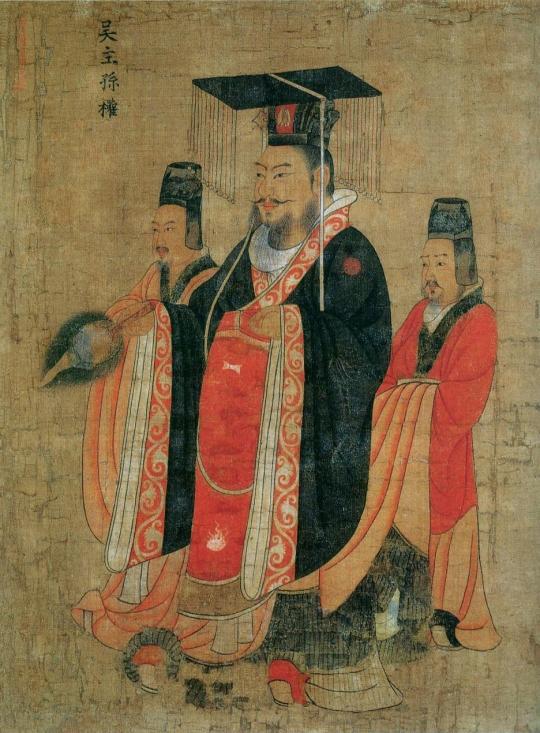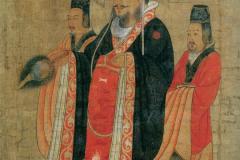Lifespan: (182-252), died at age 70. Age 7 when Dong Zhuo seized the Imperial government (189). Age 14 when Cao Cao seized the Imperial government (196). Age 18 during the Battle of Guandu (200). Age 26 during the Battle of Chibi (Red Cliff)(208).
Birth/Death place: born in Fuchun (modern Fuyang, Zhejiang). Died naturally at Jianye.
Emperor Wu Dadi (r. 222-252), personal name Sun Quan (182-252), courtesy name Sun Zhongmou, was the founder of the Wu dynasty (222-280) that ruled over of the Three Kingdoms (220-280). He was the younger brother of Sun Ce and son of Sun Jian, a warlord in the last decade of the Later Han period (25-220).
He came from Fuchun (modern Fuyang, Jiangsu) and took part in his brother’s conquest of the lower Yangtze region. When Sun Ce died in 200, Sun Quan took over his troops and his administrative apparatus. Sun Quan was able to attract a lot of capable political advisors, like Zhou Yu, Zhang Zhao, Cheng Pu, Lu Su, and Zhuge Jin.
In 208, when the powerful warlord of the north, Cao Cao, threatened to conquer the middle Yangtze valley, Sun Quan was so frightened that he thought about offering his submission, yet Zhou Yu and Cheng Pu suggested creating an alliance with Liu Bei who controlled the region of Shu in the Sichuan Basin. The united army was able to defeat Cao Cao’s troops in the battle of the Red Cliff (Chibi, modern Puqi, Hubei). The outcome of Chibi was that none of the three remaining warlords, Liu Bei, Cao Cao, and Sun Quan were able to conquer the territory of the others. Consequently, the Three Kingdoms were established.
When Cao Cao’s son Cao Pi proclaimed the Wei dynasty (220-265) in 220, Sun Quan officially accepted him as the new sovereign, and was rewarded for this step with the title of Prince of Wu. By 222, Sun Quan consolidated his territory and proclaimed himself Emperor of Wu with the capital Wuchang (modern Echeng, Hubei). He choose a reign motto, established his own court and later moved the capital to Jianye (modern Nanjing, Jiangsu). Sun Quan expanded his territory to the south, pacified the native tribes in the hills of Fujian and Hunan, and advanced to the South China Sea.
Sun Quan’s alliance with Liu Bei continued; although, the armies of Wu conquered the middle Yangtze region in a war where general Guan Yu was killed. Liu Bei wanted to avenge his slain brother and invaded Jingzhou. In the battle of Yiling, Sun Quan defeated the troops of Liu Bei and pressed him back into the Sichuan Basin. Yet in order to check the expansion of the empire of Wei, Sun Quan and Liu Bei made peace again.
Sun Quan’s political survival depended to a large extent cooperation with the local gentry of the lower Yangtze region, so that he had to include members of the eminent families in his administration and granted them large tracts of lands that had been conquered in the hill regions. The mountain tribes (shanyue) were forced to cede their lands that were settled by Chinese immigrants. The economic power of the southern gentry endowed them with a lot of political influence that the Wu government always respected. The political friction between different groups at the Wu court endangered the new dynasty. In his later years, Sun Quan demoted his crown prince Sun He and killed the Prince of Lu, Sun Ba, before nominating his youngest son Sun Liang (r. 252-258 CE) as his heir.
One of Mao’s introductory notes to the epic discusses the author’s narrative technique in dealing with the three heroes of the Sun clan—Sun Jian, Sun Ce, and Sun Quan: “The death of Sun Jian and the introduction of Sun Ce are narrated for the sake of Sun Quan, who in this chapter is merely mentioned by name, but ultimately becomes the southern counterpart of Xuande and Cao Cao—the rulers of their kingdoms. Hence, Quan is the principal and Jian and Ce the foils. And yet Jian and Ce are the principals with respect to Yuan Shao and Gongsun Zan. However, since in the account of Gongsun Zan, Xuande suddenly appears and then disappears and is recommended by Zan as governor of Pingyuan, then Zan is written off because of Xuande, and Yuan Shao because of Zan. In that case the war between Shao and Zan becomes the major theme [due to connection with Xuande] and Jian’s attack on Biao, the minor. Why so? Sun Quan [is relatively less important because he] took only a share of Han’s domain while Xuande was Han’s legitimate continuator. Inasmuch as the division of the realm is the main theme, Zan, Shao, and the rest become the foils. And among the three kingdoms, Xuande is the principal and Sun Quan his foil. Taking an overview of this chapter, Yuan Shao made war on Gongsun Zan, but the author’s main interest was in Xuande; Sun Jian attacked Liu Biao, but the author’s interest was in Sun Quan. The relative positions of major and minor must be finely discriminated by readers of Three Kingdoms.”
Sources:
Chen Shou, et al. (c. 280). Sanguozhi “Records of the Three Kingdoms”. Additions were added by Pei Songzhi (c. 400), named: Sanguozhi zhu “Annotations to Records of the Three Kingdoms”.
Fan Ye, et al (c. 450). Hou Hanshu “Book of the Later Han”, a.k.a. “History of the Later Han”.
Mao Zonggang (c. 1660). Sanguo Yanyi “Romance of the Three Kingdoms.” Mao Lun/Mao Zonggang recension editions based on Luo Guanzhong’s earlier editions. Mao Zonggang, and his father Mao Lun, was the editor of the mid-1660s edition of Three Kingdoms, the one translated in both the C.H. Brewitt-Taylor and the Moss Roberts version. In the commentaries, the form “Mao’s comment:” indicates a translation of an interlinear note to the text by Mao Zonggang in the Moss Roberts’ version.
Yan Liben (c. 650). Thirteen Emperors Scroll – Liu Bei, the Emperor of Shu Han, Sun Quan, the Emperor of Wu. Tang dynasty painting, Boston Museum of Fine Arts. Accessed Jan. 2020 – https://commons.wikimedia.org/wiki/Thirteen_Emperors_Scroll. Images are in the public domain.
Zhu Zongbin 祝總斌 (1992). “Wu Dadi Sun Quan 吳大帝孫權”, in: Zhongguo da baike quanshu 中國大百科全書, Zhongguo lishi 中國歷史, vol. 3, pp. 1235-1236. Beijing/Shanghai: Zhongguo da baike quanshu chubanshe. Chinaknowledge.de, March 8, 2011. Accessed Jan. 2020 – https://www.chinaknowledge.de/History/Division



